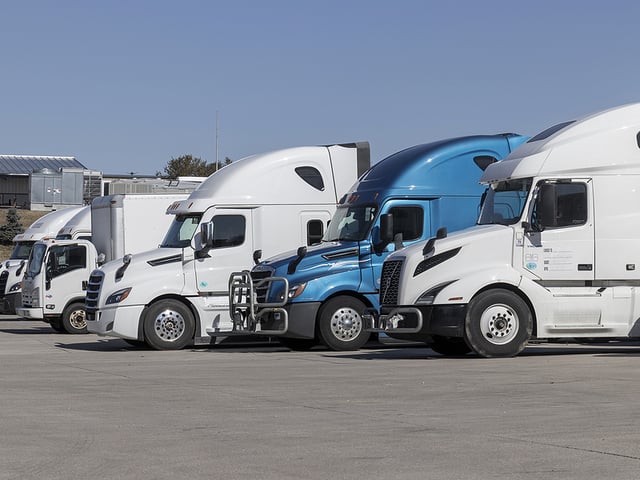
What are the Three Tests for the CDL Permit?
If you’re looking to embark on a career in truck driving, obtaining a Commercial Driver’s License (CDL) is an essential prerequisite. The CDL certification process ensures that drivers possess the knowledge and skills necessary to operate commercial vehicles safely on the roads. The journey begins with acquiring a CDL permit, and to do so, every applicant must pass the universally required General Knowledge Test. This test forms the cornerstone of the CDL, laying the foundation of commercial driving principles. Beyond this, depending on the specific class of CDL you’re aiming for and the type of equipment you plan to operate, there might be additional tests such as the Combination Vehicles or Air Brakes tests. Being well-prepared and understanding the focus of these tests, whichever are relevant to your aspirations, will significantly enhance your chances of success on the first attempt. Below you’ll find the three tests you’ll need to pass to obtain a CDL permit, as well as a discussion of other endorsements that might be required depending on the vehicle you drive.
General Knowledge Test
The General Knowledge Test is foundational for all CDL applicants, regardless of the specific class or endorsement they’re pursuing. It ensures all drivers have a baseline understanding of commercial driving rules, safety practices, and basic operational principles. This test is mandatory for all potential CDL holders.
Topics Covered on the General Knowledge Test
-
Basic Vehicle Operation: This dives into the mechanics of large vehicles, teaching you about engine components, transmission specifics, and how various systems within the truck function.
-
Pre-Trip Inspections: Safety begins before the journey does. Understand the critical aspects of vehicle checks, ensuring your vehicle is roadworthy and safe for travel.
-
Basic Control of Your Vehicle: Operating a commercial vehicle is vastly different from driving a car. Learn how to manage its size, weight, and blind spots.
-
Communicating with Other Drivers: Discover the importance of signals, lights, and horn usage in communicating intentions to other road users.
-
Managing Space Around Your Vehicle: A larger vehicle means a larger responsibility. Understand how to maneuver in tight spaces and the importance of maintaining safe distances from other vehicles.
-
Seeing and Being Seen: Grasp the art of effective use of mirrors, ensuring clear visibility and understanding the common blind spots in commercial vehicles.
-
Driving in Various Weather Conditions: Rain, snow, fog, or heatwaves - learn how different weather conditions impact your driving and how to stay safe.
-
Responding to Emergencies: Whether it’s a tire blowout, brake failure, or an unexpected obstacle, knowing how to handle emergencies is crucial.
Preparation Tips
-
Review the Manual: The CDL manual of your specific state is your bible in this journey. It’s detailed, comprehensive, and tailor-made to help you ace the test. Dedicate time to read, re-read, and understand it thoroughly.
-
Practice Tests: Theoretical knowledge is pivotal, but practice brings perfection. By taking CDL practice tests, you can identify your strengths, work on your weaknesses, and get a feel for the real test format.
2. Combination Vehicle Test
Many commercial vehicles on the road, especially in long-haul trucking, are combination vehicles—meaning a tractor pulling one or more trailers. Because of the prevalence and complexities of these vehicles, many CDL applicants will need this endorsement to maximize their employment opportunities. It’s especially relevant for those pursuing a Class A CDL, which allows the holder to operate combination vehicles with a Gross Combination Weight Rating (GCWR) over 26,000 pounds, provided the towed vehicle is over 10,000 pounds.
Topics Covered on the Combination Vehicle Test
-
Coupling and Uncoupling: This topic goes beyond merely attaching or detaching trailers. It encapsulates understanding the various types of hitch connections, safety inspection pre- and post-coupling, and the proper procedures to ensure a secure attachment. An improperly coupled trailer can lead to dangerous situations, so mastering this process is paramount.
-
Inspecting Combination Vehicles: Unlike regular vehicles, combination vehicles come with their own unique set of inspection challenges. This involves checking the integrity of the connection points, ensuring the brakes of the trailer are responsive, and more. A thorough inspection ensures that both the truck and its trailer(s) are roadworthy.
-
Using Air Brakes Effectively: Combination vehicles predominantly use air brakes. This topic educates drivers on the system’s intricacies, from understanding brake lag to ensuring optimal air pressure. It’s not just about stopping the vehicle; it’s about doing so safely and predictably.
-
Anti-lock Braking Systems (ABS): ABS is crucial for preventing skidding during sudden braking events. In combination vehicles, understanding how ABS works in tandem across both the truck and trailer is vital for maintaining control during emergency stops.
-
Distance Dynamics: Operating a combination vehicle means adjusting to its unique dynamics. This topic delves into the safe following distances, the extended stopping distances required due to added weight, and understanding the scenarios that might lead to rollovers, such as sharp turns or sudden maneuvers.
Preparation Tips
-
Real-World Exploration: If circumstances allow, spend time observing or even assisting seasoned drivers with combination vehicles. This tactile experience, coupled with witnessing real-world coupling and inspections, can be invaluable.
-
Deep Dive into Air Brakes: Given their pivotal role in safe driving, dedicate focused study sessions to air brake systems. Consider using multimedia resources like videos or interactive modules to aid in understanding this complex topic.
-
Practice and Simulations: Before the actual test, try accessing simulators or practice sessions, if available in your area. They offer a practical, risk-free environment to hone your skills and build confidence.
3. Air Brakes Test
A significant number of commercial vehicles, especially the larger ones like buses and trucks, use air brakes. Understanding how to operate and inspect air brake systems is crucial for safety. Therefore, if a driver intends to operate a vehicle equipped with air brakes, they must take and pass this test. Notably, in many states, if an applicant doesn’t pass the Air Brakes test, their CDL will be restricted to operating only vehicles without air brakes.
Topics Covered on the Air Brakes Test
-
Parts of an Air Brake System: Before operating a system, one must understand its components. This section dives into the specifics of the various parts involved, such as the compressor, air tanks, brake chambers, and valves. Each component plays a crucial role, and knowing their functions will empower a driver to utilize the system to its fullest and maintain it properly.
-
Using Air Brake Systems: While having theoretical knowledge is essential, practical application is just as vital. This topic focuses on the nuances of effectively using air brakes, from understanding brake lag to managing air pressure and adjusting brake sensitivity.
-
Inspecting Air Brake Systems: An effective inspection can be the difference between a safe journey and a hazardous situation. Drivers learn to identify potential issues before they escalate, ensuring that the air brake system is in optimal condition every time they set out. This includes checking for air leaks, ensuring adequate pressure, and verifying the correct operation of the brake controls.
-
Air Brake System Failures: No system is immune to failures. What sets a seasoned driver apart is not just their ability to prevent such situations but their preparedness and response when things go wrong. This topic educates drivers on the common signs of system failures, how to respond in the event of a failure, and the preventive measures that can minimize such occurrences.
Preparation Tips
-
Visual Learning: Diagrams, models, and videos can be incredibly beneficial in understanding the intricacies of the air brake system. If possible, get hands-on experience by inspecting a real system, identifying its parts, and understanding their roles.
-
Safety First: Always approach the subject with safety at the forefront of your mind. Grasping why certain procedures are in place can significantly bolster your understanding and recall. For example, understanding the catastrophic consequences of an air brake failure can underline the importance of routine inspections.
-
Discussion and Mentorship: Engaging with seasoned truck drivers or mentors can provide invaluable insights. Their real-world experiences can offer context to theoretical knowledge, helping you grasp not just the ‘how,’ but the ‘why’ behind air brake operations.
Exploring Additional CDL Endorsements
In the commercial driving landscape, certain foundational tests like the General Knowledge Test, Air Brakes, and Combination Vehicles are pivotal for every aspiring driver. However, the expansive realm of commercial transportation encompasses a wide variety of vehicles and cargoes. Tailoring to specific roles or niches in the industry often means pursuing further endorsements beyond the foundational tests. These specialized endorsements stand as a testament to a driver’s expertise and training in distinct sectors of commercial driving. Let’s explore these endorsements and their significance in the world of commercial transportation.
1. Hazardous Materials (H) Endorsement
Transporting hazardous materials, from toxic chemicals to explosives, requires a heightened level of responsibility and care. Earning this endorsement indicates that a driver understands the unique rules, precautions, and handling techniques associated with hazardous cargo.
2. Tank Vehicles (N) Endorsement
Driving tank vehicles, especially those carrying liquids or gaseous substances, presents its own set of challenges, such as the potential for surge or the need for specialized handling. This endorsement ensures that drivers are familiar with these challenges and can safely operate tank vehicles.
3. Passenger (P) Endorsement
If you’re considering a role where you’ll be responsible for transporting passengers—be it a city bus, a shuttle, or a coach—this endorsement is crucial. It covers the specific rules and responsibilities of ensuring passenger safety during transit.
4. School Bus (S) Endorsement
Specifically designed for school bus drivers, this endorsement emphasizes not only the safe transportation of students but also the rules surrounding pick-up and drop-off, emergency evacuation procedures, and student behavior management.
5. Double/Triple Trailers (T) Endorsement
For drivers intending to haul more than one trailer, this endorsement tackles the complexities associated with multiple trailers. From coupling and uncoupling to understanding the dynamics of how double/triple trailers move on the road, this endorsement is vital.
6. Motorcycle (M) Endorsement
While not directly related to trucking, some states include the motorcycle endorsement within the realm of CDLs. For drivers looking to operate two-wheelers, especially in a commercial capacity, this endorsement might be necessary.
Remember, while the aforementioned endorsements are common, individual states may have their own additional requirements or specifications. Before embarking on your commercial driving journey, research your state’s specific mandates to ensure you’re fully qualified for your desired role. Acquiring the right endorsements not only widens your employment opportunities but also ensures you’re adequately trained to handle the challenges of your chosen commercial driving path.
CDL Journey: Key Takeaways
The pathway to becoming a commercial driver is multi-faceted. It begins with the universally required General Knowledge Test, a foundation for all CDL applicants. For those interested in combination vehicles or those equipped with air brakes, specialized tests await. Beyond these foundational assessments, the commercial transportation arena offers a spectrum of endorsements, from transporting hazardous materials and passengers to handling tank vehicles and multiple trailers. Each endorsement represents a specialized sector within the broader commercial driving landscape, emphasizing the diverse nature of this profession. As you embark on this journey, remember the importance of thorough preparation. Utilize our practice tests, study guides, and flashcards tailored for CDL aspirants to bolster your understanding and readiness. Your future in commercial driving hinges on knowledge and dedication, and we’re committed to supporting your aspirations.
Keep Reading

Commercial Driver's License Test Blog
How Many Questions are on the CDL Permit Test?
Embarking on a career in commercial truck driving begins with a crucial…

Commercial Driver's License Test Blog
How Much Does It Cost to Get a CDL?
The trucking industry dominates freight shipping. Trucks handle over 70…

Commercial Driver's License Test Blog
The CDL Manual by State: Everything You Need to Know
Are you ready to average over $81,997 per year with numerous career and…